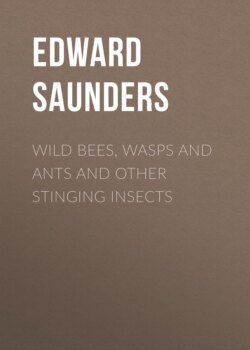Читать книгу Wild Bees, Wasps and Ants and Other Stinging Insects - Edward Saunders - Страница 9
На сайте Литреса книга снята с продажи.
THE SOLITARY BEES
ОглавлениеTable of Contents
The life-history of an ordinary pair of solitary bees is, roughly, as follows: I will take for an example one of the spring species of Andrena. Many people know the little red bee, which for some apparently unaccountable reason suddenly appears in myriads on their lawn or gravel path, throwing up little mounds of finely powdered earth—in this respect being quite different from worm casts, which are formed of wet mould and the particles of which cling together—sometimes causing considerable alarm as to the possible effect on the lawn. These have hatched out from burrows made by their parents in the previous year, the mouths of which have been filled up with earth and therefore are quite invisible till the newly fledged bees gnaw their way out. They, in their turn, are now making fresh burrows for their own broods; possibly they infested some one else's lawn the year before or were only in comparatively small numbers on the lawn under notice and so passed unrecognized. They may safely be left alone, as they never seem to breed many consecutive years in one such locality: probably the treatment of a lawn does not suit them, mowing and rolling upsetting their arrangements. We will now consider these arrangements. The female bee, so soon as she realizes that she is charged with the duty of providing for her future offspring, makes a burrow in the ground, and the earth thrown up from the tunnel forms the little heap which is so observable; this burrow varies in depth from 6 to 12 inches and has short lateral branches; each of these she shapes, more or less, into the form of a cell, provisions it with a small mass of pollen mixed with honey for the maintenance of the larva when hatched, and lays her egg; she then seals up that cell and proceeds to the next, and in this way fills the burrow up until pretty near the surface. The bee caterpillar when hatched is a white grub-like creature which, after devouring the food provided for it, becomes more or less torpid; it then makes its final change of skin, after how long a period is probably uncertain, and appears in the nymph stage. Fig. 1. Bombus, larva and nymph: after Packard. This stage corresponds to the chrysalis of a moth or butterfly, the creature being shortened up and rather more like the perfect insect compacted into the smallest form possible. People are often misled into the idea that the caterpillar forms the chrysalis over its former self, whereas the chrysalis has been all the time forming inside the caterpillar and only shows itself when the final skin is shed; of course some caterpillars spin a cocoon over themselves before they change their skin, but then the true chrysalis is found inside the cocoon. A curious fact connected with the change from the nymph to the perfect insect is that this takes place sometimes as early as August in the year preceding their appearance; so that cells dug up in August may contain fully fledged insects which are not due to appear till April or May of the following year. It is wonderful also how long life can be sustained by these creatures in the "full-fed larva" condition. Some years ago I collected a number of pierced bramble stems in order to breed out some of the small "sandwasps" which nest in them. On opening them in May, when the perfect insects are generally ready to appear, I found that several of the larvæ had rather shrunk up and had not changed into nymphs. These I left in the stems, covering them up again, and they appeared as perfect insects in the May of the following year.
The account given of the nesting habits of the above Andrena of our lawns, etc., is more or less true of nearly all the solitary bees. Their methods vary, some burrow in the ground, some in old wood, some in snail shells, some in bramble stems or straws or the hollow stems of various plants, some in holes or crevices in walls, etc., and their methods of building their cells vary exceedingly: all of these are of great interest and some display an ingenuity which is quite surprising. Of these special nesting habits some of the most striking will be mentioned later on.
Before leaving these general remarks on the solitary bees the habits of two genera must be specially noticed, as they differ in an essential point from those of the others. These are known to entomologists under the names of Halictus and Sphecodes.
In most species of these the males and females of the new brood are not hatched out till after midsummer, and no work is done for the provisioning of new burrows that autumn; but the female, after having undertaken the duties of maternity, hibernates, i.e. goes back into a burrow and lives there till the next spring, the males dying off before the winter. In the spring the ♀ wakes up and does the necessary work for the future brood just as any ordinary spring bee would—but there are no attendant males—the duties of that sex having been performed in the autumn. The larvæ contained in these burrows hatch out after midsummer and therefore never spend a winter in the ground. In this respect they resemble the social bees and wasps, about which more hereafter; in the meanwhile a few words must be said about the cuckoos or inquilines, which are perhaps the most interesting creatures of all.
